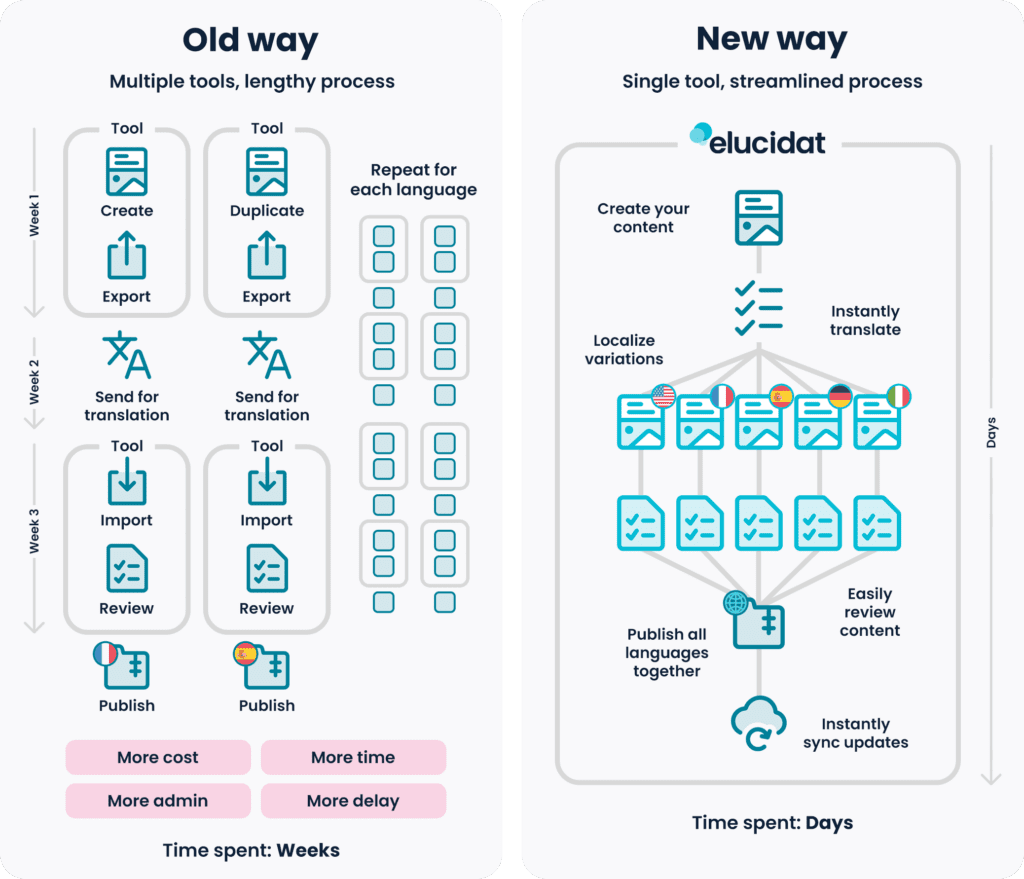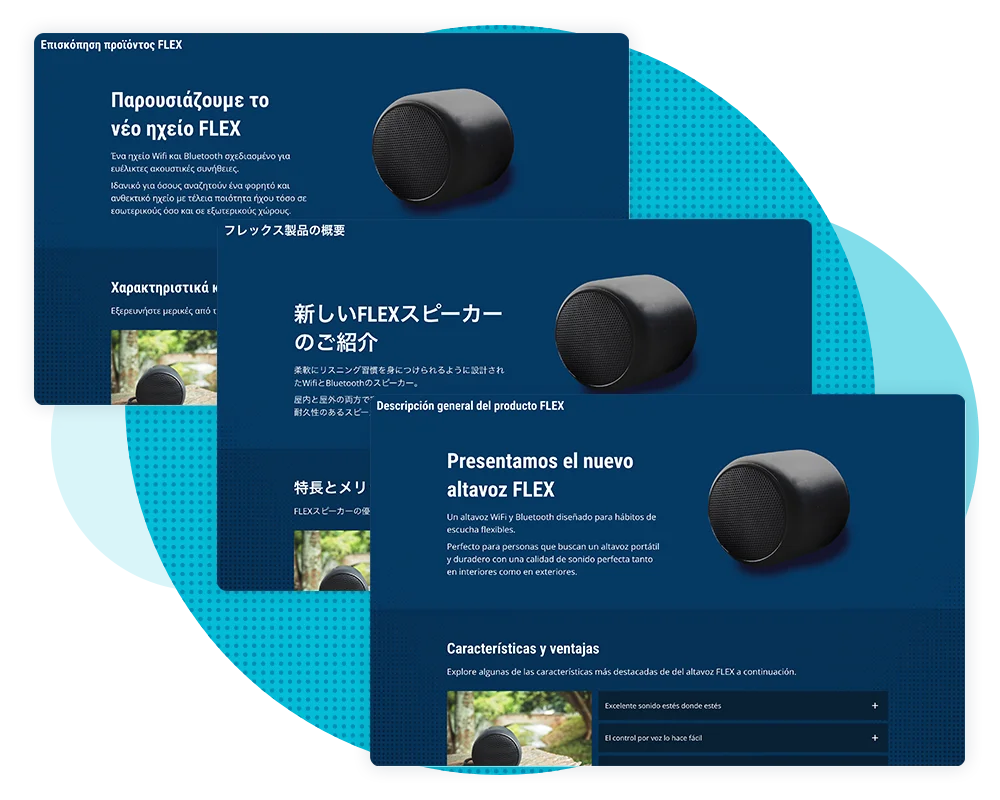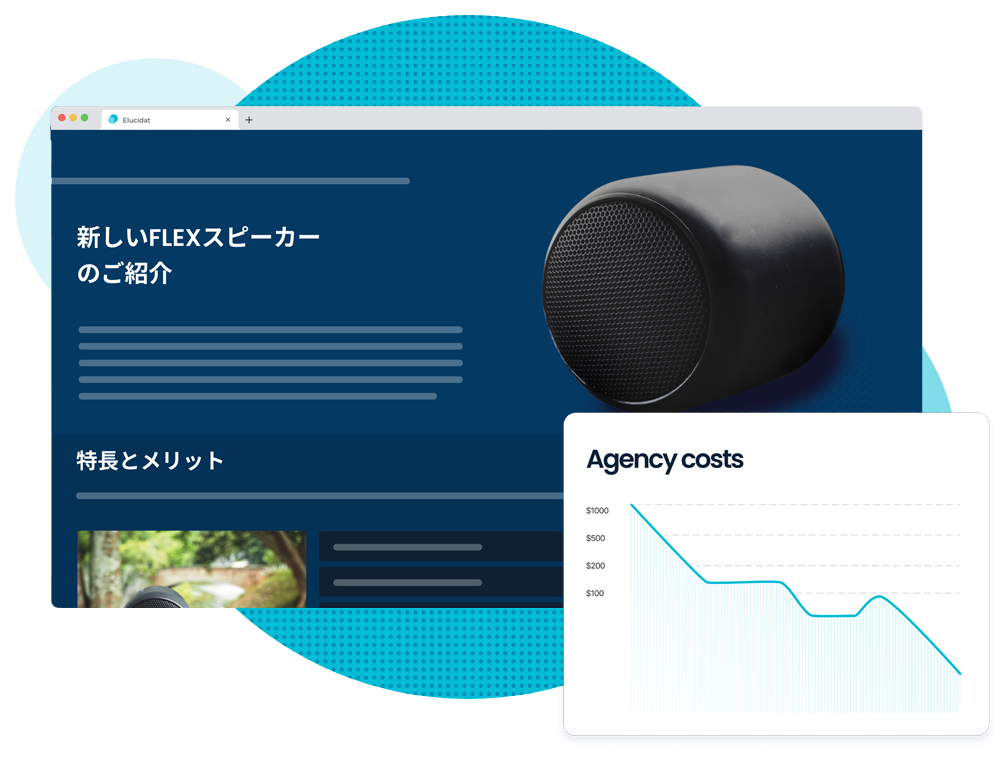Introduction
Want your digital learning to make an impact across the globe? You need to speak your learners’ language – literally. EdTech data reveals when elearning is localized into languages it boosts productivity by 50%. But delivering this impact with truly accessible, relevant, and effective digital learning globally isn’t straightforward.
Whether it’s struggling with version control or relying on expensive external translation agencies, the challenges stack up. And without the right tools and processes in place, costs and timescales can quickly escalate.
However, there is another way. Leading organizations are moving away from traditional translation methods and adopting scalable, centralized, and streamlined ways of working.
This guide sets out how they’re doing this, including processes and tools, examples, and checklists to help you do the same.
The current state of play: Multi-language learning in global enterprises
In today’s fast-paced, global enterprises, elearning translation is a must. With more digital learning content and a growing list of language requirements, L&D teams need to scale up their translation efforts. Add in the complexity of multiple authoring platforms and translation tools, and suddenly, the workload skyrockets.
It’s no wonder many organizations turn to external translation agencies – increasing costs and extending their timelines. Or worse, leave their employees to struggle in a second language – causing a massive dip in the effectiveness of the learning.
Under pressure to do more with less, L&D teams need new streamlined ways to deliver global digital learning with real impact. That means moving away from external agencies and setting up centralized processes that remove the challenges of in-house translation, boosting efficiency, and delivering more impactful global learning experiences.
The consequences of traditional learning content translation methods
Before we explore what this new approach to elearning translation looks like, let’s dive deeper into why the traditional methods aren’t cutting it.
Having outlined the significant drawbacks of traditional translation methods, we’ll now delve into best practices that streamline processes and enhance content delivery across languages.
Best practices for managing multi-language
learning content efficiently
Leading organizations are ditching traditional methods in favor of smarter, in-house solutions for delivering impactful multi-language learning content. The key to doing this successfully? Scalable, centralized, and streamlined processes powered by automation and Artificial Intelligence (AI).
Let’s take a look at each of these below.
Scalable
Don’t wait for the translation requests to start stacking up. Shift from being reactive to proactive by setting up a clear, consistent process that will help you to scale-up elearning translation without stress. With the right approach, you can empower everyone to play an effective part in meeting your growing language needs, while maintaining control, quality, and consistency.

Do
Empower employees with smart tools and quick processes to translate proactively.

Don’t
React to increasing translation needs by falling back on ineffective methods.
Centralized
Managing separate language versions is a headache that can lead to errors and discrepancies. Keep all your translations in one place. From brand alignment to regular updates, a centralized workflow will help you maintain consistency and relevance across multiple languages.

Do
Select tools that centralize your translation efforts for better control and consistency.

Don’t
Duplicate content for every language – chaos will follow.
Streamlined
Avoid unnecessary work and rework by streamlining your process. Define roles and responsibilities at each stage, so everyone knows what’s expected of them. When a task is clear, people can stay focused and collaborate more efficiently and effectively to deliver successful translations.

Do
Standardize translation processes with defined roles for SMEs, translators and reviewers.

Don’t
Assume centralization will magically fix everything – clarity and structure are key.
Leverage automation and AI
Automation and AI can help you streamline your process, slashing translation time and effort. Instead of starting from scratch or outsourcing, AI gives you an initial translation that can be reviewed for final tweaks. Less time. Less cost. More efficiency.

Do
Explore authoring tools with automation, AI translation and review features built in for a more seamless experience.

Don’t
Rely fully on automated translation or your translations could be full of inconsistencies and errors – human review is non-negotiable.
Now, let’s explore how effective localization ensures our content not only communicates but truly connects with global audiences.
Localization vs translation
To fully engage learners from various cultural backgrounds, organizations must go beyond mere translation. Giving your learners the freedom to select their preferred language is a great start.
Let’s look at a great example of this:

However, to truly connect with global learners, you need to localize your content. It’s not just about replacing words in one language with equivalent ones in another language. Localization is all about making the learning feel right for the region, respecting cultural nuances and local contexts.
Effective localization:
- Improves accessibility
- Increases learner engagement
- Delivers better outcomes
- Improves culture
- Increases brand loyalty
Localizing your learning content does complicate the translation process, creating more work and adding more variation between language versions. Fortunately, with the right centralized, streamlined, and automated approach, localization becomes easy.
4 tips for effective elearning localization
So, how do you put this into practice? Here are four tips to help you with localization:
- Start early: Initiate localization at the course design stage to ensure adaptability of structure, visuals, and content, paving the way for seamless cultural integration.
- Engage local experts: Collaborate with local language speakers and subject matter experts to ensure content is both accurate and culturally attuned.
- Test content: Pilot your courses with a target audience to refine language and cultural relevance based on direct feedback.
- Stay updated: Continuously refresh your content to keep pace with cultural shifts and evolving learner needs.
Selecting the right tools
There are many ways to tackle elearning translation and localization. The key is to keep things simple. And that’s where an all-in-one translation management system comes in.
From developing the original digital learning to releasing your translated variations, finding the right tool for your translation needs is a game-changer.
Capabilities to look for:
- Languages: Confirm that the tool translates into your organization’s target languages.
- Glossary: Make sure the tool allows you to create a glossary of key terms for reference during automated translations – saving you time and effort during the review process.
- Review: Check out the tool’s review workflow. Can you centrally manage the review process? How easy is it for your reviewers to provide feedback on the translation?
- Updates: Explore how updates are deployed across all language variations. Are updates made to each language variation or made once and automatically applied to all variations?
- Release: Identify the tool’s release options. Can you release each language separately and create multi-language courses?
- Integration: Ensure the tool you select works smoothly with your Learning Management System (LMS) or other platforms.
Selecting an all-in-one translation management system simplifies and streamlines the entire elearning translation process, from creation to release, ensuring efficiency and integration with existing systems.
Now let’s take a quick look at real-world example…
Case study: MaxMara’s Global Reach

International luxury fashion brand, MaxMara is a great example of how it’s possible to deliver impactful content globally. Serving their 10,000+ global audience in their native language is a given, through the easy in-built translation process.
They create high-end, fully on-brand elearning that’s fit for fashion houses and genuinely inclusive of their staff in different regions. This approach ensures that MaxMara’s training content reaches and resonates with individuals working on any sub brand and in any language.
The ideal translation management workflow
Feeling inspired and ready to transform your translation process? Here’s what the new improved workflow looks like compared to the traditional methods.

Moving from…
- Multiple tools
- Duplicated courses for each language
- Manual export / import of language files
- Translation review in documents
- Time consuming updates
- Lengthy process
Moving to…
- A single tool
- All language variations centralized
- Instant machine translation
- Integrated review tool
- Update synced across variations
- Streamlined process
The multi-language learning checklist
So, how do you get up and running with this new multi-language learning management system? It’s more involved than just choosing a tool and clicking the “Translate” button. With a wide range of features and workflows, you need to make sure your system meets your needs.
Consider the areas in this checklist as you work through the deployment process.
Pre-deployment
Deployment
Post-deployment
In summary
In today’s fast-paced, global enterprises, L&D teams need to scale up their translation efforts. Traditional translation methods aren’t delivering the impactful global learning experiences that employees want and need.
Here’s a recap of what to take forward:
- Limiting the languages may simplify things, but it also reduces the impact, lowers learner engagement and can lead to potential compliance risks
- Using external agencies outsources your translation effort, but this comes with increased costs and timelines, and it’s not scalable.
- In house translation provides more control but many organization struggle to make it work at scale.
The solution? Centralize, streamline, and automate. With the right multi-language learning management system, you can:
- Speed up translation
- Reduce cost and effort
- Simplify learning content management
- Maintain consistency, accuracy and relevance
- Increase the impact of your learning
We can help you do it!
Get a smarter, faster way to produce transformative global elearning with Elucidat’s Auto-Translate.
Find more about how our multi-language translation feature can help you simplify elearning translation.
We’ll even tailor your demo to show you how we can help you solve your biggest elearning translation challenges.


